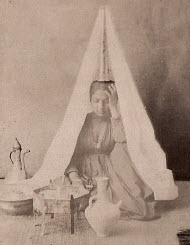head-dress, headdress
A headdress is first mentioned in Exodus 28:40 (King James Version: “bonnets;” Revised King James Version: “head-tires”). It was used especially for purposes of ornament (Job 29:14; Isaiah 3:23; 62:3).
Types of headdress
Hebrew: tsaniph—properly means a turban, folds of linen wound round the head
Hebrew: peer—used in Isaiah 61:3, there rendered “beauty” (King James Version) and “garland” (Revised King James Version)
This is a headdress or turban worn by females (Isaiah 3:20, “bonnets”), priests (Exodus 39:28), a bridegroom (Isaiah 61:10, “ornament;” Revised King James Version, “garland”).
Ezek. 16:10 and Jonah 2:5 are to be understood of the turban wrapped round the head.
Hebrew: shebisim (Isaiah 3:18), in the King James Version rendered “cauls,” and marginal note “networks”—denotes probably a kind of netted head-dress
-
Hebrew: keren—the “horn” mentioned in 1 Samuel 2:1
This is the headdress called by the Druses (Druzes) of Mount Lebanon the “tantura,” “tantour,” “tantoura.”
More information
